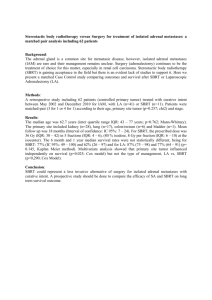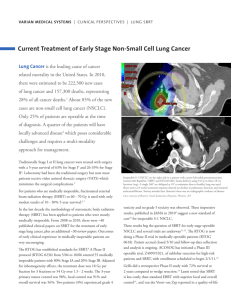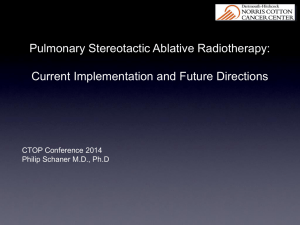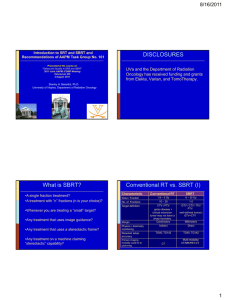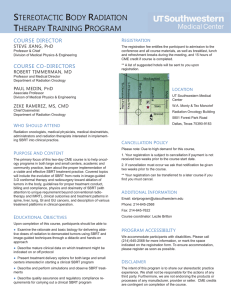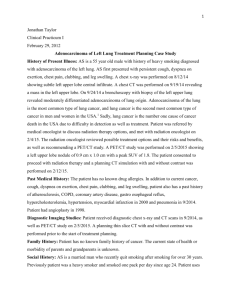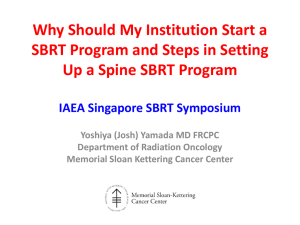EDUCATIONAL COURSE TU-A-BRB-1 Physics and Dosimetry of SBRT
advertisement
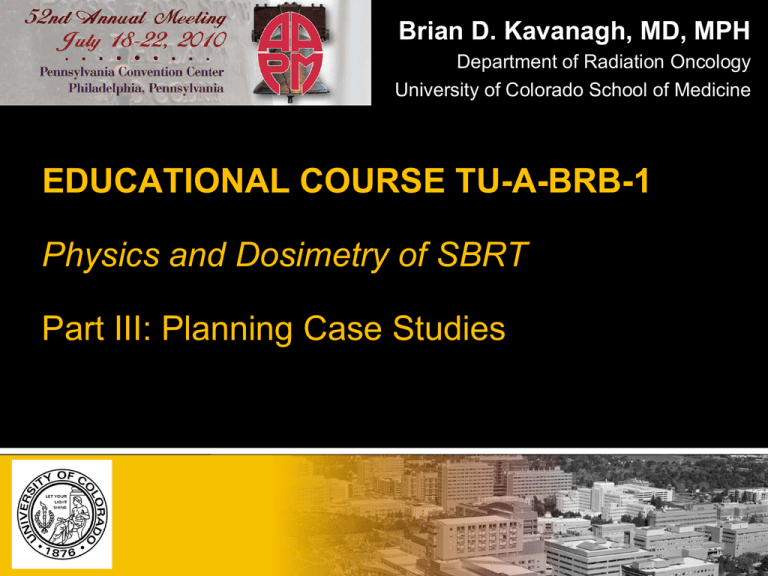
Brian D. Kavanagh, MD, MPH Department of Radiation Oncology University of Colorado School of Medicine EDUCATIONAL COURSE TU-A-BRB-1 Physics and Dosimetry of SBRT Part III: Planning Case Studies 3 of the AAPM SBRT sessions • HOW do we and some others do SBRT? – Tuesday 730 am, “Physics and Dosimetry of SBRT”, moderator M Miften, Educational Session • WHY did we reach this place? – Tuesday 130 pm, “Establishing an SBRT Program”, moderator S Benedict, Practical Medical Physics • WHAT have we accomplished so far? – Wednesday 130 pm, “Stereotactic Body Radiotherapy (SBRT): Technical and Clinical Considerations”, moderator I Chetty, Therapy Symposium Spectrum of applications of SBRT • Intensified treatment to a primary cancer – Stage I lung cancer – Primary HCC – Pancreas cancer – Prostate cancer • Palliation/control for challenging sites of recurrence – Spinal – Retroperitoneal – Previously irradiated volumes • Adjuvant systemic cytoreductive therapy – “Radical” treatment for isolated liver, lung, spine, and other oligometastases Top to Bottom: HOW do we and some others do SBRT? • Recurrent head and neck cancer • Early stage lung cancer – And lung metastases • Pancreas cancer • Hepatocellular cancer – And Liver metastases • Spine/paraspinal lesions • Prostate cancer Top to Bottom: HOW do we and some others do SBRT? • Recurrent head and neck cancer • Early stage lung cancer – And lung metastases • Pancreas cancer • Hepatocellular cancer – And Liver metastases • Spine/paraspinal lesions • Prostate cancer Heron et al, IJROBP 2009 CPT code semantics • SBRT term can be used for fractionated brain tumor SRS for the MD pro fee Delivery code = SRS MD pro fee = SRS if 1 fxn, SBRT for 2-5 fractions Can be boost – But the delivery code is SRS • SRS is the term used for primary OR BOOST treatment to base of skull region tumors • SBRT describes an entire course of treatment, not a boost phase of treatment Delivery code = SBRT MD pro fee = SBRT if 1-5 fxns Complete course, not boost Pittsburgh H&N SBRT Rgiawe et al, AJCO 2010 •Previously established normal tissue dose limits in Phase I study • For Spinal cord: • 8 Gy in 1 fraction • 12 Gy in 2 fractions • 9 Gy for the brainstem • 20 Gy for the brain • 10 Gy for the retina, optic nerves, and chiasm • 6 Gy for the lens of the eye • 20 Gy for the carotid artery • 20 Gy for the esophagus and larynx. • Immobilization via thermoplastic mask •Treatment given every other day 7/53 Sample HN SBRT case, UCH • • • • • • • 81 yo M with T3 N0 M0 SCC of the L true vocal cord. Pt with prior T1a SCC of L true vocal cord treated to 70 Gy/35 fractions in 11/2000. Plan: 25 Gy/5 fxns with cetuximab PTV (38.81cc): 94% volume gets 25 Gy – max=2941 cGy – min=1635 cGy – mean=2745 cGy GTV (12.11cc): 99.5% volume gets 25 Gy – max=2941 cGy – min=2345cGy – mean=2813 cGy cord: 1% max=830 cGy @ approx C5-C6 – max=1028 cGy – mean=413cGy Esophagus: V15=0.59cc, max=2353 cGy,min=49 cGy,mean=551 cGy FOLLOWUP 7 mos: – NED on exam and PET Immobilization alternatives Top to Bottom: HOW do we and some others do SBRT? • Recurrent head and neck cancer • Early stage lung cancer – And lung metastases • Pancreas cancer • Hepatocellular cancer – And Liver metastases • Spine/paraspinal lesions • Prostate cancer The technical necessities for SBRT • Immobilization – Needs to be comfortable since treatments sometimes lengthy • Image guidance – Need to relocalize target prior to each treatment – Removes need for rigid body frame • Breathing motion management – Passive • Margin-based – Active • Abdominal compression • Controlled breath-hold • Gated beam-on devices cineMRI courtesy of Dr. Paul Read, Univ. of Virginia Respiratory control for SBRT • Abdominal compression – Forces shallow breathing • Controlled breath-hold – Stabilizes tumor within the respiratory cycle – Can be device-assisted • Tumor tracking – Implanted fiducials • Gated beam-on devices – Treatment only given when tumor located within the beam – Respiratory tracing used Quantitative analysis of abdominal pressure relative to breathing motion Heinzerling et al, IJROBP 70(5):1571–1578, 2008 Note: high compression force approx 90N, or approx 22 pounds, reduced diaphragm sup-inf motion from approx 15mm to 8 mm on average 4D CT simulation note: belt higher than for liver Liver case Comparison of the 2 lung SBRT chest/rib toxicity studies Dunlap, IJROBP 2009 U Virginia & U Colorado Pettersson, Radiother Oncol 2009 Sahlgrenska U, Sweden • 60 patients, minimum point dose 20 Gy in 3-5 fractions to chest wall • Endpoint: severe pain (narcotics) or rib fracture • DVHs analyzed: • 81 ribs in 26 patients,minimum point dose 21 Gy/3 fractions received • Endpoint: rib fracture on CT • DVHs analyzed – Chest wall = all tissue (bone and soft tissue) peripheral to lung – Ribs receiving >21 Gy contoured without margin for setup errors Common finding: absolute volume predictive parameters Dunlap et al: Keep absolute V30 < 30 cc Petterssen et al: Keep D2cc as low as possible Solving irregular breathing: pranayama breathing Free breathing Pranayama breathing Cautionary note: Possible problems near the proximal airways Freedom from grade 3-5 toxicity Timmerman et al, JCO, October, 2006 2 responses to the IU proximal airway report BELOW: from Joyner et al, Acta Oncol 2006; 45: 802-807 Chang et al, IJROBP 2008; 72(4) 967–971 • UT-SA experience (above) – n=9; dose = 3x12 Gy – No serious toxicity • Median f/u 11 mos (range, 3-42) • MD Anderson experience – N = 27; dose = 4x10-12.5 Gy – No serious lung toxicity • Median f/u 17 mos (range, 6-40) • 1 brachial plexopathy (>40 Gy/4 fxns) LEFT: from Chang et al, IJROBP 2008; 72(4) 967–971 Another example case • Aug, 2008: – 59yo F with h/o metastatic NSCLC s/p surgery/WBRT 1 year ago – only current site of disease = 5cm mass in rt mid lung. – plan: SBRT to rt lung mass One year later: cough, dyspnea Coronal reconstruction, CT scan Chest x-ray Bronchoscopy: mucus plug cleared from RML bronchus Lateral segment RML bronchus: Narrow but patent after clearing This can also happen after hyper-fractionated RT Miller et al, IJROBP 61: 64-69, 2005 Pre- and post-bronch to clear mucus plug Radiation Pneumonitis Ricardi et al, Acat Oncol 2009 • 63 patients – 9/63 Grade 2+ RP • Correlated with MLD2 – No toxicity when MLD2 ≤ 12 Gy • Median 4.8 months Radiation Pneumonitis Borst et al,Radiother Oncol 2009 • 128 patient treated with SBRT • 10.9% pneumonitis • Correlated to MLD2 Top to Bottom: HOW do we and some others do SBRT? • Recurrent head and neck cancer • Early stage lung cancer – And lung metastases • Pancreas cancer • Hepatocellular cancer – And Liver metastases • Spine/paraspinal lesions • Prostate cancer A DOSIMETRIC MODEL OF DUODENAL TOXICITY AFTER STEREOTACTIC BODY RADIOTHERAPY FOR PANCREATIC CANCER Murphy et al, IJROBP, in press •73 pts • No prior RT • Unresectable • Not recurrent after Whipple •25 Gy single fraction • PTV = GTV + 2 to 3mm • duodenum constraints: • 5% < 22.5 Gy • 50% <12.5 Gy • the 50% isodose line shouldnot reach the distal wall of the duodenal lumen on any CT image A DOSIMETRIC MODEL OF DUODENAL TOXICITY AFTER STEREOTACTIC BODY RADIOTHERAPY FOR PANCREATIC CANCER Murphy et al, IJROBP, in press •Only 6/73 grade 3+ duodenal toxicity •Numerous individual predictors significant on univariate •NTCP also significant (not shown) Murphy et al, continued Pancreas SBRT v conventional RT Stanford, IJROBP 2010 •Primary unresectable •25 Gy/1 fxn •84% GEM-based chemo •Toxicity: • 8% (6/73) G3-4 duodenal toxicity • Other toxicities not stated RTOG, JAMA. 2008;299(9):1019-1026 •Adjuvant post-op, GTR •50.4 Gy/28 with 5FU •GEM or 5FU neo and adj •Toxicity: • 58% total nonhematologic toxicity G3-4 • • • • Diarrhea Stomatitis Other GI etc Other sources of guidance for SBRT normal tissue dose constraints •Selected RTOG SBRT studies •QUANTEC papers—very limited SBRT, mostly conventional • Liver • Pan et al, IJROBP 76(3) Suppl: S94–S100, 2010 • Kidney • Dawson et al, IJROBP 76(3) Suppl: S94–S100, 2010 • Stomach and small bowel • Kavanagh et al, IJROBP 76(3) Suppl: S94–S100, 2010 •Timmerman RD. Sem Rad Onc 18(4): 215-222, 2008 • Mostly unvalidated but well considered estimates for 1, 3, and 5 fractions Timmerman RD. Sem Rad Onc 18(4): 215-222, 2008 3 fraction dose guidelines Colorado Phase I/II Liver SBRT Trial, Schefter et al, IJROBP 62:1371-78, 2005 Methods – Standard 3+3 Phase I design – Starting dose, 12 Gy x 3 = 36 Gy total – Safe escalation to pre-selected maximum dose • 20 Gy x 3 = 60 Gy • Critical volume model – At least 700 cc normal liver received < 15 Gy cumulative absolute volume of univolved liver, cc 2500 2000 1500 This difference must be > 700 1000 500 0 0 10 20 30 40 50 dose 34 Timmerman RD. Sem Rad Onc. 18(4) :215-222, 2008 Liver Case: 3DCRT vs. IMRT Prescription Dose: 54 Gy to PTV in 3 Fxs GTV in RED, PTV in CYAN 3D 60 Gy 54 Gy 48 Gy 30 Gy Both plans use 10 coplanar fields IMRT UC Liver SBRT Phase II Results, Toxicity No RILD, no Gr 4-5 toxicity of any kind 1 case of grade III soft tissue toxicity What not to do: Insufficient number of fields Photo taken 8 mos after SBRT At last followup 17 post-SBRT, lesion controlled. Necrosis is slowly healing. Chest wall contouring Note: In this case we accepted a slightly high chest wall V30 of 44 cc. The pain syndrome reported had typical onset 7 mos post-SBRT and lasted approx 4 mos. Most pt recovered to zero pain level. Thus, an important consideration but should be judged relative to overall clinical goal. MINIP vs MIP: a few comments Notice one obvious difference between MINIP and MIP is the volume of liver projected, since the lower density adjacent tissues that move with respiration provide the minimum HU voxels. We generally use ITV+5mm margin for lung and liver MIP usually helpful for lung ITV MINIP often helpful for liver ITV, but be careful with lesion near the dome MINIP (above) helpful to show ITV for 2 of the three lesions, but 4D CT cine view (right) shows actual motion of dome lesion outside of MINIP-based ITV. Non-protocol patient: max pt to stomach >10 Gy/fxn Pale, denuded mucosa; progressed to ulceration but eventually healed in approx 3 mos Sometimes you just can’t do 3 fractions and keep max GI point dose to <10 Gy/fractions Yes, that is a liver metastasis— unusual anatomy! Stomach, not small bowel, adjacent Stomach V40 = 2.25 cc “4/40 rule” = keep total GI tract volume >40 Gy to <4cc Top to Bottom: HOW do we and some others do SBRT? • Recurrent head and neck cancer • Early stage lung cancer – And lung metastases • Pancreas cancer • Hepatocellular cancer – And Liver metastases • Spine/paraspinal lesions • Prostate cancer Range of applied cord constraints Institution Dose Constraint MSKCC 14 Gy Dmax UPMC 10 Gy Dmax HENRY FORD V10Gy < 10% MDACC 12 Gy Dmax TO 0.1 CC PMH 12 Gy Dmax TO THECAL SAC OR CORD + 2mm CLEVELAND CLINIC 14Gy Dmax AND V10Gy <10% STANFORD 14 Gy Dmax, V12Gy < 0.3 CC, V10Gy < 0.5 CC V8Gy < 1 CC DALLAS 14 Gy Dmax, V10Gy < 0.35CC, V8Gy < 1.2CC Yosh Yamada, MSKCC, from ASTRO IGRT mtg, 2009 The easy part for spinal targets: motion is not a major problem cineMRI courtesy Dr Paul Read, U of Virginia Spinal Target volumes, from “Partial Volume Tolerance of the Spinal Cord and Complications of Single-Dose Radiosurgery” Ryu et al, Cancer, 2007 • • • Cord drawn 6mm above and below target Major constraint: no more than 10% of cord receives dose above 10 Gy Only 1 observed cord complication among 177 pts Sample case: 60 y/o F • 5/04 T1N2M0 NSCLC – Adjuvant chemo (gem/carbo) • 5/05 bone mets – Erlotinib started 9/05 • Mid-2006 – spine SRS T7,sacrum – Brain SRS 3 lesion • Early 2007 – SRS to another brain met • Late 2007 – SRS to 2 other brain mets • Early 2008 – Progressing spine lesions at T10, L3 Target volume and plan Top to Bottom: HOW do we and some others do SBRT? • Recurrent head and neck cancer • Early stage lung cancer – And lung metastases • Pancreas cancer • Hepatocellular cancer – And Liver metastases • Spine/paraspinal lesions • Prostate cancer From Katz et al, BMC Urology 2010 7.25 Gy x 5 F Note: caution with testis dose using CK system Multi-institutional trial First UC patients 10 Gy x 5F Note: balloon placed to displace rectum and take advantage of reduced backscatter dose Thanks for your attention!
